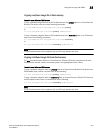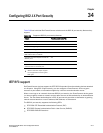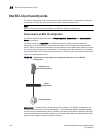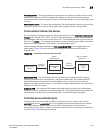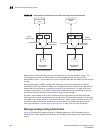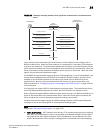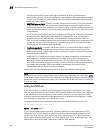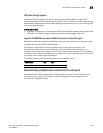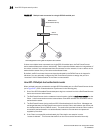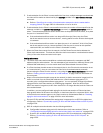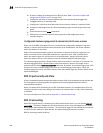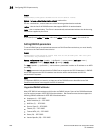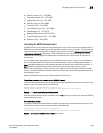
1222 PowerConnect B-Series FCX Configuration Guide
53-1002266-01
How 802.1X port security works
34
activities. Since EAP-TLS requires PKI digital certificates on both the clients and the
authentication servers, the roll out, maintenance, and scalability of this authentication method
is much more complex than other methods. EAP-TLS is best for installations with existing PKI
certificate infrastructures.
• EAP-TTLS (Internet-Draft) – The EAP Tunnelled Transport Level Security (TTLS) is an extension
of EAP-TLS Like TLS, EAP-TTLS provides strong authentication; however it requires only the
authentication server to be validated by the client through a certificate exchange between the
server and the client. Clients are authenticated by the authentication server using user names
and passwords.
A TLS tunnel can be used to protect EAP messages and existing user credential services such
as Active Directory, RADIUS, and LDAP. Backward compatibility for other authentication
protocols such as PAP, CHAP, MS-CHAP, and MS-CHAP-V2 are also provided by EAP-TTLS.
EAP-TTLS is not considered foolproof and can be fooled into sending identity credentials if TLS
tunnels are not used. EAP-TTLS is suited for installations that require strong authentication
without the use of mutual PKI digital certificates.
• PEAP (Internet-Draft) – Protected EAP Protocol (PEAP) is an Internet-Draft that is similar to
EAP-TTLS. PEAP client authenticates directly with the backend authentication server. The
authenticator acts as a pass-through device, which does not need to understand the specific
EAP authentication protocols.
Unlike EAP-TTLS, PEAP does not natively support user name and password to authenticate
clients against an existing user database such as LDAP. PEAP secures the transmission
between the client and authentication server with a TLS encrypted tunnel. PEAP also allows
other EAP authentication protocols to be used. It relies on the mature TLS keying method for its
key creation and exchange. PEAP is best suited for installations that require strong
authentication without the use of mutual certificates.
Configuration for these challenge types is the same as for the EAP-MD5 challenge type.
NOTE
If the 802.1X Client will be sending a packet that is larger than 1500 bytes, you must enable jumbo
at the Global config level of the CLI. If the supplicant or the RADIUS server does not support jumbo
frames and jumbo is enabled on the switch, you can set the CPU IP MTU size. Refer to “Setting the
IP MTU size”, next.
Setting the IP MTU size
When jumbo frames are enabled on a PowerConnect device and the certificate in use is larger
than the standard packet size of 1500 bytes, 802.1X authentication will not work if the supplicant
or the RADIUS server does not support jumbo frames. In this case, you can change the IP MTU
setting so that the certificate will be fragmented before it is forwarded to the supplicant or server
for processing. It is supported in the Layer 3 router code.
To enable this feature, enter the following command at the Global CONFIG level of the CLI.
PowerConnect(config)# ip mtu 1500
Syntax: [no] ip mtu <num>
The <num> parameter specifies the MTU. Ethernet II packets can hold IP packets from 576 –
1500 bytes long. If jumbo mode is enabled, Ethernet II packets can hold IP packets from 576 –
10,222 bytes long. Ethernet SNAP packets can hold IP packets from 576 – 1492 bytes long. If
jumbo mode is enabled, SNAP packets can hold IP packets from 576 to 10,214 bytes long. The
default MTU is 1500 for Ethernet II packets and 1492 for SNAP packets.




